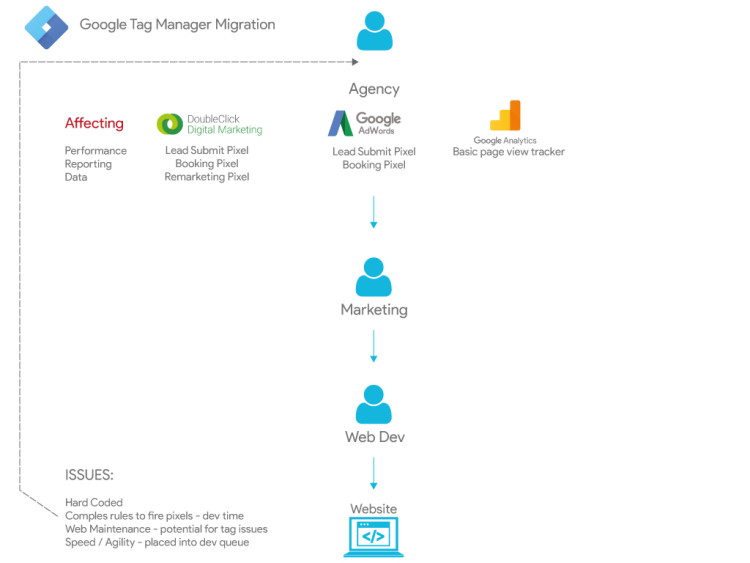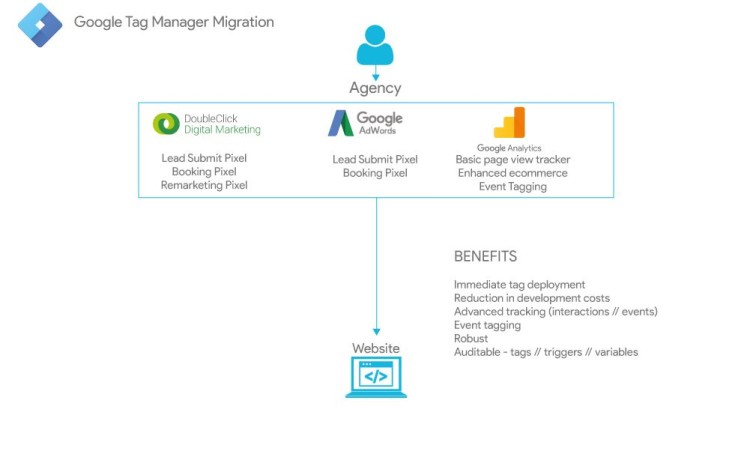Setting up web analytics correctly can be complex and time consuming. Get it right, and you can make confident decisions on how to spend your search budget in order to feed the most profitable part of your business. Get it wrong, and your spend will not be optimized to your market/audience, and might be completely wasted.
From our experience, one of the biggest analytics opportunities for web marketers is to use tools like Google Tag Manager (GTM) to facilitate tag management. In many businesses, setting this up can involve many different stakeholders – such as web development teams, product managers, and IT. Whilst tag management systems can save a lot of time and effort, they need significant up-front investment of time and effort to set up, and getting internal commitment from other teams is a challenge.
This blog post provides some examples of how to build an internal business case for setting up a tag management system.
Building a case to use a tag management system
When undertaking digital marketing, we utilize various technologies and advertising platforms. To measure the effectiveness of these campaigns, we need to implement tags or pixels that can track activity. Tools like Google AdWords, Google Analytics and DoubleClick use tags or pixels (a line of code), which need to be added to your website either on every page, or only on a certain page, or only in certain set of circumstances.
However, when there are multiple pixels for multiple tools, along with complex rules related to when each one fires, your digital marketing plans can be held up or stifled by the web development team. Without a tag management system, they would need to spend lots of time writing these rules one by one, draining valuable development resources. Without this we are limited on what data we collect and we have problems with reporting and data.
For example, if you just added the standard GA code to all pages, you will only be able to track pageviews, so if you want to track any other events or interactions, a developer would have to implement a solution to fire event tags relating each individual item that you wanted to track interactions against. The diagram below illustrates the problems when there’s no tag management solution in place:

Solution – Google Tag Manager
Although there are several different tag management products on the market, GTM has become the most popular, as it is free, easy to use and integrates with Google Analytics. All tag managers including GTM are deployed by adding a ‘container code’, which is a small snippet of code (similar to the Google Analytics tracking code), to the <body> section of every page of the website. Container codes can be thought of as ‘buckets’ that hold other types of tags.
This one piece of container code replaces all marketing tags previously used, including the GA code, as those tags are set up in the Google Tag Manager web interface and not in the HTML code. We have written another blog post which discusses all the technical implications in more detail.
Here are just a few benefits to this system:
- Reduced labor costs – it is much less time intensive to create rules to trigger tags using a tag management solution.
- Reduced lead time – With GTM, marketers can get tags deployed live much faster, as the power is in their hands with no need to involve a developer.
- Reduced risk – Since website code is not being amended, there is no risk of breaking a page or interfering with content.
- Easy deployment of new tags – new tags can be quickly and easily deployed without using development resources.
The diagram below shows how easy it is for the agency or the marketer to have control of GTM. The tagging code only needs to be added to the website by your development team once:

Summary
Implementing a tag management solution requires a significant up-front investment of time and effort, often from multiple teams within a business. Long-term, the ease and speed of implementing changes will free up scarce resources and enable you to optimize your digital marketing strategy based on evidence.
Search Laboratory are a GACP (Google Analytics Certified Partner) and can advise on the implementation of Google Tag Manager. Please let us know if you have any questions.


